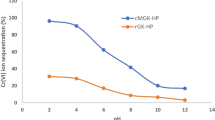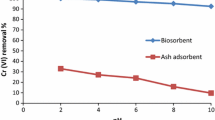Abstract
In this work, hazelnut hull is suggested as an adsorbent to remove Fe(III) from aqueous solutions. The removal of Fe(III) was investigated as a function of adsorbate initial concentration, solution initial pH, temperature, contact time, and the adsorbent amount. Under optimum conditions (pH 3, adsorbent amount 0.6g, temperature 30C, time 70min), the maximum removal of Fe(III) cations was 83.5%. Both the Langmuir and Freundlich isotherms were suitable for describing the adsorption of Fe(III) on hazelnut hull. The capacity of the hazelnut hull for adsorption of Fe(III) was 13.59mg/g.
Similar content being viewed by others
Avoid common mistakes on your manuscript.
Background
Iron is widely used in industry as plumbing, gear wheel, and roofing. However, excessive iron can be harmful for the environment. Furthermore, in humans, it will cause stomach upset and ulcer, mental retardation, liver, and brain damage. Excessive amounts of Fe(III) in public water supplies caused turbidity, unpleasant taste, and odor[1–3]. Therefore, removal of iron from effluents is essential.
Various methods have been reported regarding the removal of heavy metals including thermal, biological, physical, and chemical treatments[4, 5]. However, these methods are expensive and difficult; therefore, there is a serious need for the development of the easy and low cost methods. In recent years, there has been an increase in the use of biological materials as adsorbents for the removal of heavy metals from aqueous solutions. Agricultural by-products, such as banana pith, rice bran, peanut hull, sunflower, sugar beet pulp, orange peel have been demonstrated to remove heavy metal ions from wastewater[6–16].
The adsorption behavior of Cu(II), Pb(II), Cd(II), Ni(II) and methylene blue[17–19] from aqueous solutions on the hazelnut hull had previously been investigated. This paper presents the study of biosorption characteristics of powdered hazelnut hull for removing Fe(III) from aqueous solutions. The adsorption of hazelnut hull for Fe(III) was shown as a function of initial pH, adsorbent and adsorbate concentrations, temperature, and contact time. The adsorbent-adsorbate equilibrium behavior has been investigated using Langmuir and Freundlich isotherms.
Results and discussion
Effect of variables
The effect of Fe(III) concentration on the sorption by the hazelnut hull was investigated by varying the Fe(III) concentration from 20 to 60g/mL (Figure1). At low concentrations, Fe(III) cations in the solution were adsorbed almost 100%. However, at higher concentrations, cations were unadsorbed due to the saturation of the adsorption sites.
The effect of pH on Fe(III) adsorption onto hazelnut hull was studied over pH range 1 to 5. The results are in Figure2. The optimum uptake occurred at pH 3.0 when 81.0% of the Fe(III) was eliminated from the solution. At very low pH, the surface of sorbent would be surrounded by the hydrogen ions, which compete with Fe(III) ions during the binding of the biosorbent sites. When the pH is increased (pH>4), the Fe(OH)3 can be produced and the removal was decreased.
The temperature of the solution-sorbent mixture was investigated in a range of 10C to 70C. Figure3 shows the effect temperature on the of adsorption. Maximum adsorption was obtained at 30C.
Figure4 shows the effect of contact time on adsorption. According to this figure, the uptake of Fe(III) by hazelnut hull shows an increase from 40 to 60min. The maximum uptake occurred when the contact time was 60min. In this situation, 82.3% of the Fe(III) was removed from the solution.
The dependence of the Fe(III) adsorption on the adsorbent amount was studied by varying over range of 0.1 to 0.7g, at other variables constant (Figure5). With increasing adsorbent amount, the removal of Fe(III) increased and became almost constant at 0.6g of adsorbent. Therefore, this amount was selected as the optimum value.
Adsorption isotherms
Langmuir and Freundlich isotherms were employed to study the biosorption process. These are most commonly used to describe the biosorption characteristics of adsorbents used in water and wastewater treatment.
The linear form of Langmuir isotherm is given by the following equation:
where qe is the amount adsorbed at equilibrium (mg/g), Ce is the equilibrium concentration (mg/L), and q m and b (L/mg) are the Langmuir constants related to maximum adsorption capacity and energy of adsorption, respectively. The Langmuir constants for adsorption of Fe(III) using hazelnut hull are given in Table1. The capacity of the hazelnut hull for adsorption of Fe(III) in the optimized conditions was 13.59mg/g.
The adsorption data were also analyzed by Freundlich equation. The logarithmic form of Freundlich equation is given in the following equation:
where K f (mg/g) and n are constants related to adsorption capacity and adsorption intensity, respectively. The Freundlich constants are also given in Table1. The good correlation coefficients showed that the two models are suitable for studying the adsorption equilibrium of Fe(III).
Experimental
Hazelnut hull and chemicals
Hazelnut hull was cleaned and dried to a constant weight at room temperature and was then ground to pass through a 40-mesh sieve for experiments. Fourier transform infrared spectroscopy spectrum of the hazelnut hull was shown in Bulut and Tez[19]. All solutions were prepared with double distilled water. Chemicals used were of analytical grade. Stock solution of Fe(III), 1,000mg/L, was prepared by dissolving 0.4321g of Fe(NO3)3 (Merck & Co., Inc., Whitehouse Station, NJ, USA) in water in a 1,000mL volumetric flask. The Fe(III) concentration in the solution was determined by an atomic absorption spectrometer (Varian-AA220 Spectrometer, Salt Lake City, UT, USA). Temperature control and shaking were performed by the water bath shaker (NB-303 Orbital, Merton, London, UK). A pH meter (ISTEK Inc., Kuro-ku, Seoul, South Korea) was used to determine the pH. Solutions of NaOH and HNO3, 0.1mol/L, were used to adjust the solution pH).
Conclusions
This study shows that hazelnut hull is a suitable adsorbent for the removal of Fe(III) from aqueous solution due to its high capacity adsorption, availability, and low cost. The Fe(III) removal was pH-, adsorbent amount-, and contact time-dependent. Under optimum conditions, the maximum removal of Fe(III) and the capacity of adsorbent (based on Langmuir equation) were found to be 83.5% and 13.59mg/g, respectively.
References
Volesky B, Holan ZR: Biosorption of heavy metals. Biotechnol Prog 1995, 11: 235. 10.1021/bp00033a001
Ramos L, Fernndez MA, Gonzlez MJ, Hernndez LM: Heavy metal pollution in water and earthworms from the Ebro river (Spain). Bull Environ Contam Toxicol 1999, 63: 305. 10.1007/s001289900981
Singh AK, Singh DP, Panday KK, Singh VN: Wollastonite as adsorbent for removal of Fe(II) from water. J Chem Technol Biotechnol 1998, 42: 39.
Volesky B: Biosorption of heavy metals. Florida: CRC press, Boca Raton; 1990.
Aksu Z: Application of biosorption for the removal of organic pollutants: a review. Process Biochem 2005, 40: 997. 10.1016/j.procbio.2004.04.008
Gndogan R, Acemioglu B, Alma MH: Copper (II) adsorption from aqueous solutions by herbaceous peat. J Colloid Interface Sci 2004, 269: 303. 10.1016/S0021-9797(03)00762-8
Shin EW, Karthikeyan KG, Tshabalala MA: Adsorption mechanism of cadmium on juniper bark and wood. Bioresour Technol 2007, 98: 588. 10.1016/j.biortech.2006.02.024
Wang XS, Qin Y, Li ZF: Biosorption of Zinc from aqueous solutions by rice bran: kinetics and equilibrium studies. Sep Sci Technol 2006, 41: 747. 10.1080/01496390500527951
Farajzadeh MA, Monji AB: Adsorption characteristics of wheat bran towards heavy metal cations. Sep Purif Technol 2004, 38: 197. 10.1016/j.seppur.2003.11.005
Basci N, Kocadagistan E, Kocadagistan B: Biosorptiion of copper (II) from aqueous solutions by wheat shell. Desalination 2004, 164: 135. 10.1016/S0011-9164(04)00172-9
Altundogan HS: Cr (VI) removal from aqueous solution by iron (II) hydroxide loaded sugar beet pulp. Process Biochem 2005, 40: 1443. 10.1016/j.procbio.2004.06.027
Pagnanelli F, Toro L, Vegli F: Olive mill solid residues as heavy metal sorbent material: a preliminary study. Waste Manage 2002, 22: 901. 10.1016/S0956-053X(02)00086-7
Li Q, Zhai Z, Zhang W, Wang M, Zhou J: Kinetic studies of adsorption of Pb(II), Cr(III) and Cu(II) from aqueous solution by sawdust and modified peanut husk. J Hazard Mater 2007, 141: 163. 10.1016/j.jhazmat.2006.06.109
Prasanna Kumar Y, King P, Prasad VSRK: Zinc biosorption on tectona grandis L.f. leaves biomass: equilibrium and kinetic studies. Chem Eng J 2006, 124: 63. 10.1016/j.cej.2006.07.010
Kim JW, Sohn MH, Kim SS, Sohn SM, Kwon YS: Production of granular activated carbon from waste walnut shell and its adsorption characteristics for Cu2+ ion. J Hazard Mater 2001, 85: 301. 10.1016/S0304-3894(01)00239-4
Ho YS, McKay G: The kinetics of sorption of divalent metal ions onto sphagnum moss peat. Water Res 2000, 34: 735. 10.1016/S0043-1354(99)00232-8
Demirbas O, Karadag A, Alkan M, Dogan M: Removal of copper ions from aqueous solutions by hazelnut shell. J Hazard Mater 2008, 153: 677. 10.1016/j.jhazmat.2007.09.012
Dogan M, Abak H, Alkan M: Biosorption of Methylene Blue from Aqueous Solutions by Hazelnut Shells: Equilibrium, Parameters and Isotherms. Water Air Soil Pollut 2008, 192: 141. 10.1007/s11270-008-9641-z
Bulut Y, Tez Z: Adsorption studies on ground shells of hazelnut and almond. J Hazard Mater 2007, 149: 35. 10.1016/j.jhazmat.2007.03.044
Acknowledgement
The authors are thankful to the Islamic Azad University, Yazd branch for the support of this work.
Author information
Authors and Affiliations
Corresponding author
Rights and permissions
Open Access This article is distributed under the terms of the Creative Commons Attribution 2.0 International License (https://creativecommons.org/licenses/by/2.0), which permits unrestricted use, distribution, and reproduction in any medium, provided the original work is properly cited.
About this article
Cite this article
Sheibani, A., Shishehbor, M.R. & Alaei, H. Removal of Fe(III) ions from aqueous solution by hazelnut hull as an adsorbent. Int J Ind Chem 3, 4 (2012). https://doi.org/10.1186/2228-5547-3-4
Received:
Accepted:
Published:
DOI: https://doi.org/10.1186/2228-5547-3-4









